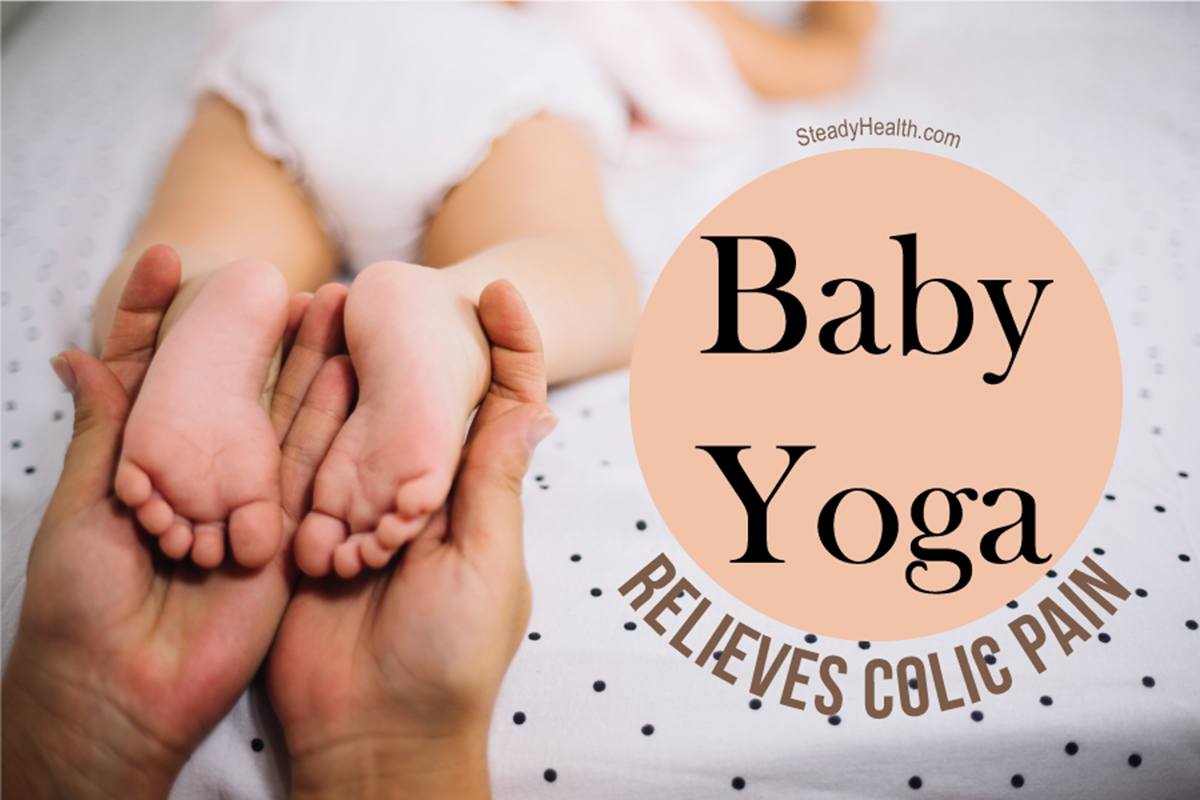What causes colic and why all babies don’t experience the symptoms remains a mystery. Some doctors say it’s a natural developmental stage caused by the baby's adjustment to new sensations outside the womb. Others claim colicky pain is due to an imbalance of bacteria in the gut. [1, 2] Whatever the reason, the fact is that colic is quite common in babies younger than three months. Estimates are that it affects at least a quarter of all infants during the first few months of their lives. [3]
It’s a benign condition where a baby cries approximately for 3-6 months, but is otherwise healthy [4]. We call it “colicky pain” because babies look and act like they’re sick, although nobody knows if they are actually in pain and how much. Some experts believe that colic occurs in all babies, just not at equal intensities, so it often goes unnoticed [5].

Yoga And Exercises For Colicky Pain
There's a relatively new concept in the western world known as "Mother and baby yoga“ where postpartum mothers discover the benefits of working out with their precious newborns. Studies have shown mother and baby yoga helpful for the physical and emotional health of the mother, but it also has a handful of health benefits for babies, including better digestion and a lower incidence of colicky symptoms. [6]
Leg Pump — A baby lies flat on the back. Gently pump their legs towards the tummy. Work with the baby, there’s no need to force the legs if the baby doesn't want to do it. You can do this for couple of minutes. Perhaps you’ll hear some gas noises along the way, and it’s a good thing if you do.
Abdominal Twist (Jathara Parivartanasana) — Bring the baby’s knees up towards the chest. Hold their left shoulder with your right hand; with your left hand bend both of their legs and move the knees to the right side. Repeat the process on the other side as well.
Half Lotus Position (Ardha Padmasana) — This position is similar to what we grown ups do when trying to stretch the glutes. Lay your baby down on the back, put their left leg in a 90 degree angle, and put the right leg across. Pull both legs towards the belly. You may repeat this a few times. Repeat on the other side as well. When you're done, gently pull the legs down to stretch the hips a little.
Reclining Bound Angle Position (Supta Baddha Konasana) — Start by putting the soles of your baby's feet together, then pull the legs up towards the stomach. Release.
Walking — A simple walk with your baby in a stroller may be an excellent exercise for both of you. Going outside with a screaming infant isn't something that most parents would do, but some doctors claim that fresh air may help with colicky pain. [5] Even if it wasn't the case, it might clear your head, and the motion of the stroller may soothe the baby.
Stability Ball Colic Bounce — Sitting and bouncing on a stability ball while holding onto the baby may bring relief. Gently bounce up and down while holding your little crier. This is not good just to calm the baby; it’s also an excellent workout for your legs. [7] The gentle bouncing motion and the comfort of your arms can soothe your baby, and if you get tired, ask your spouse to step in. If you don’t have the stability ball, just use the side of your bed.
In Addition To Baby Yoga And Exercises For Colic
Even though colicky pain in infants is not caused by any specific food, some foods are proven to worsen the symptoms of colic. If your baby has colic, try removing the foods that may worsen the symptoms such as too much spices, caffeine, dairy products, leafy greens, and cruciferous vegetables such as cabbage or broccoli. Reducing cow's milk from mother's diet showed improvements in some infants with colic. [8]
Even though gas doesn't cause colic in infants, it's one of the most common symptoms, together with straining, pulling and extending the legs. Pediatricians now believe that excessive crying causes gas due to all the swallowed air, not the other way around as it was once believed. Your baby may seem constipated, but that's typically not the case, especially in breastfed infants — the baby is straining because he or she is learning to put pressure into the abdominal area, the thing known as Valsalva maneuver. [9]
It's always a good idea to consult a physician if you have any doubts about the health of your newborn. A pediatrician can suggest some good ideas to soothe the baby if he or she diagnoses colic, but what's more important — they can rule out other and more serious possible causes for crying.
- Photo courtesy of SteadyHealth.com

